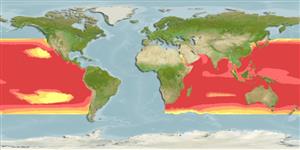Environment: milieu / climate zone / depth range / distribution range
ນິເວດວິທະຍາ
ສັດທະເລ; ປາທີ່ມີການເຄື່ອນຍ້າຍໃນສະເພາະມາະຫາສະມຸດ (Ref. 51243); ລະດັບຄວາມເລິກ 0 - 915 m (Ref. 43), usually 0 - 200 m (Ref. 43). Subtropical; 15°C - 30°C (Ref. 43); 44°N - 47°S, 18°E - 69°W (Ref. 43)
Indo-Pacific: tropical and subtropical waters, occasionally entering temperate waters. Stray individuals migrate into the Atlantic Ocean by way of the Cape of Good Hope, but the existence of Atlantic breeding stocks is unlikely. Highly migratory species.
ຂະໜາດ / ນ້ຳໜັກ / Age
Maturity: Lm ? range ? - ? cm
Max length : 465 cm FL ຕົວຜູ້/ບໍ່ມີເພດ; (Ref. 40637); common length : 380 cm TL ຕົວຜູ້/ບໍ່ມີເພດ; (Ref. 30573); ນ້ຳໜັກສູງສຸດທີ່ເຄຍຈັດພີມມາ: 750.0 kg (Ref. 5503)
ຄີ (ໜາມ)ແຂງຢູ່ຫຼັງປາ (ທັງໝົດ) : 0; ຄີຫຼັງຂອງປາ (ຄີອ່ອນ) (ທັງໝົດ) : 39 - 50; ຄີ(ໜາມ) ແຂງຢູ່ຄີກົ້ນປາ
ກຸ່ມປາກະດູກແຂງ
ຄວາມຖີ່ຂອງກຸ່ມຖ່າຍທອດພັນ
ປາທີ່ມີການເຄື່ອນຍ້າຍຈາກທະເລໄປຫານ້ຳຈືດ ແລະນ້ຳຈືດຫາທະເລ
ປາທີ່ມີການເຄື່ອນຍ້າຍຈາກທະເລແລະໄປໄຂ່ຢູ່ນ້ຳຈືດ
ຄີກົ້ນຂອງປາ
ສັດທີ່ມີກະດູກສັນຫັຼງ
ການຖ່າຍທອດທາງກຳມະພັນຈາກພໍ່ແມ່ຫາລູກ: 0; ຄີກົ້ນຂອງປາ: 16 - 21. Body elongate and not very compressed; upper jaw produced into a robust but not very long beak; two dorsal fins, the height of the first less then the greatest body depth, becoming shorter posteriorly; pectoral fins falcate and rigid, with 19 to 20 rays; body densely covered with small, embedded scales with 1 or 2 sharp points; back dark blue; belly silvery white; membrane of first dorsal fin blue black, without spots; flanks without spots (Ref. 55763). Dark blue above, silvery white below; sometimes with light blue vertical stripes; 1st dorsal fin blackish to dark blue, other fins dark brown with tinges of dark blue in some specimens.
Oceanic, usually found in surface waters above the thermocline, often near shore close to land masses, islands and coral reefs. Feed on fishes, squids, cuttlefishes, octopods, large decapod crustaceans and mostly on small tunas when abundant (Ref. 9668). The flesh is of good quality; marketed refrigerated or frozen and prepared as sashimi in Japan (Ref. 9308). Also Ref. 9692.
Life cycle and mating behavior
ການຈະເລີນເຕັມໄວ | ການສືບພັນ | ການວາງໄຂ່ | ໄຂ່ | ຄວາມດົກຂອງໄຂ່ປາ | ຕົວອ່ອນ
Believed to prefer water temperatures around 27° to 28°C during spawning. Egg counts of ripe roe totaled about 40 million per female.
Nakamura, I., 1985. FAO species catalogue. Vol. 5. Billfishes of the world. An annotated and illustrated catalogue of marlins, sailfishes, spearfishes and swordfishes known to date. FAO Fish. Synop. 125(5):65p. Rome: FAO. (Ref. 43)
IUCN Red List Status (Ref. 130435: Version 2024-2)
Threat to humans
Harmless
Human uses
ການປະມົງ: ເປັນສີນຄ້າ; ຊະນິດປາທີ່ຖືກນຳໃຊ້ເຂົ້າໃນການຫາເພື່ອເປັນເກມກິລາ: ແມ່ນ
ເຄື່ອງມື
Special reports
Download XML
ແຫຼ່ງອີນເຕີເນັດ
Estimates based on models
Preferred temperature (Ref.
123201): 16 - 28.4, mean 25.4 °C (based on 3272 cells).
Phylogenetic diversity index (Ref.
82804): PD
50 = 1.0005 [Uniqueness, from 0.5 = low to 2.0 = high].
Bayesian length-weight: a=0.00447 (0.00208 - 0.00958), b=3.13 (2.93 - 3.33), in cm total length, based on LWR estimates for this species & (Sub)family-body (Ref.
93245).
ຊັ້ນເຂດຮ້ອນ (Ref.
69278): 4.5 ±0.4 se; based on diet studies.
ຄວາມຢືດຢຸ່ນ (Ref.
120179): ຂະໜາດກາງ, ປະຊາກອນຕຳ່ສຸດທີ່ໃຊ້ເວລາສອງເທົ່າ 1.4 - 4.4 ປີ (K=0.47(?); Fec=67 million; assuming tm>2).
Prior r = 0.28, 95% CL = 0.19 - 0.42, Based on 2 full stock assessments.
Fishing Vulnerability (Ref.
59153): Very high vulnerability (78 of 100).
Climate Vulnerability (Ref.
125649): Very high vulnerability (76 of 100).
Nutrients (Ref.
124155): Calcium = 19.2 [9.1, 31.0] mg/100g; Iron = 0.771 [0.444, 1.305] mg/100g; Protein = 19.4 [18.3, 20.5] %; Omega3 = 0.224 [0.117, 0.422] g/100g; Selenium = 66.5 [32.9, 124.9] μg/100g; VitaminA = 5.68 [1.84, 17.81] μg/100g; Zinc = 0.339 [0.233, 0.495] mg/100g (wet weight);
